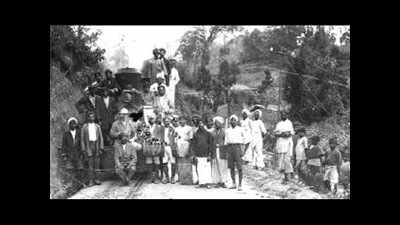- News
- City News
- kochi News
- Munnar light railway: Tata to partner state government
Trending
This story is from June 23, 2019
Munnar light railway: Tata to partner state government
Tata will be the private partner in the state government’s plan to revive the light railway in Munnar. This was revealed by the minister for cooperation, tourism and devaswom Kadakampally Surendran.

One of the steam locomotives used for light railway in Munnar which was operational from 1908 till the floods in 1924
KOCHI: Tata will be the private partner in the state government’s plan to revive the light railway in Munnar. This was revealed by the minister for cooperation, tourism and devaswom Kadakampally Surendran. The project would be developed under public-private-partnership (PPP) model, he said.
“Tata came forward and we will have further discussions with them on this matter and if we need any other agencies [for further funding], we could consider it then.Funding wouldn’t be a problem, because this project will be a big crowd-puller,” said Surendran.
Officials of Kanan Devan Hills Plantations Company (KDHP), an associate company of Tata Global Beverages Ltd, had attended a meeting at tourism minister’s office at Thiruvananthapuram, two weeks ago, where the initial talks had happened. “They came along with Devikulam MLA S Rajendran. Tourism secretary, tourism director and Devikulam sub-collector also attended the meeting, where we decided to start collecting whatever information available on the light railway, as the initial step,” Surendran said.
Tourism director P Bala Kiran said there would be a field visit to conduct a feasibility study for the revival of the railway in Munnar. “We have to find whether the land originally used for the railway is still available there. If it is feasible, the department of tourism could take it up,” he said.
Known as Kundale Valley Light Railway, the narrow-gauge railway was set up by the Scottish planters of the High Ranges in 1908. Twenty-one mile-long, it started from the current KDHP headquarters and went up to the Top Station, from where the tea chests were transported down to Bodinayakkanur using ropeway. It had stops at Nettikudi Bridge, Mattupetty, Palar, Kavangulam, Ellapatty Chowkey, Ellapatty Frontier, in between. At Top Station, tea was transferred to a ropeway which brought it to the Bottom Station at Korangany (now in Tamil Nadu) from where it was taken to Ammayanaikkanur, the nearest South Indian Railway station.
During the 1924 floods, Munnar-Mattupatty section was damaged beyond repair and hence it was dismantled in a phased manner and by World War-II, it was fully removed.
Meanwhile, a team of officials led by Idukki district tourism promotion council (DTPC) secretary Jayan P Vijayan and Kannan Devan Plantation Company official Ajoy visited the area and inspected the old railway line route from Mattuppetty to Munnar on Friday.
(With inputs from Idukki bureau)
“Tata came forward and we will have further discussions with them on this matter and if we need any other agencies [for further funding], we could consider it then.Funding wouldn’t be a problem, because this project will be a big crowd-puller,” said Surendran.
Officials of Kanan Devan Hills Plantations Company (KDHP), an associate company of Tata Global Beverages Ltd, had attended a meeting at tourism minister’s office at Thiruvananthapuram, two weeks ago, where the initial talks had happened. “They came along with Devikulam MLA S Rajendran. Tourism secretary, tourism director and Devikulam sub-collector also attended the meeting, where we decided to start collecting whatever information available on the light railway, as the initial step,” Surendran said.
Tourism director P Bala Kiran said there would be a field visit to conduct a feasibility study for the revival of the railway in Munnar. “We have to find whether the land originally used for the railway is still available there. If it is feasible, the department of tourism could take it up,” he said.
With the production of tea going up in the newly-planted hills, the planters first used 500 imported bullock carts to transport the produce – tea, coffee and cinchona – from Munnar to ports in Tamil Nadu, which was easier to access than Kochi. Sometime after 1902, an Ewing single-rail tramway (monorail) was installed by R F Thorp, the then chief engineer of KDHP, and in 1908, GW Cole, who replaced him started setting up the light railway, which took 18 months to complete.
Known as Kundale Valley Light Railway, the narrow-gauge railway was set up by the Scottish planters of the High Ranges in 1908. Twenty-one mile-long, it started from the current KDHP headquarters and went up to the Top Station, from where the tea chests were transported down to Bodinayakkanur using ropeway. It had stops at Nettikudi Bridge, Mattupetty, Palar, Kavangulam, Ellapatty Chowkey, Ellapatty Frontier, in between. At Top Station, tea was transferred to a ropeway which brought it to the Bottom Station at Korangany (now in Tamil Nadu) from where it was taken to Ammayanaikkanur, the nearest South Indian Railway station.
During the 1924 floods, Munnar-Mattupatty section was damaged beyond repair and hence it was dismantled in a phased manner and by World War-II, it was fully removed.
Meanwhile, a team of officials led by Idukki district tourism promotion council (DTPC) secretary Jayan P Vijayan and Kannan Devan Plantation Company official Ajoy visited the area and inspected the old railway line route from Mattuppetty to Munnar on Friday.
(With inputs from Idukki bureau)
End of Article
FOLLOW US ON SOCIAL MEDIA










